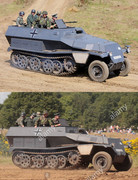The colour in photographs would also be affected by the emulsions used and the subsequent processing.
I suspect that the colour would degrade over time, both on vehicles and in the can.
Nowadays, white balance is an issue with digital photographs.
The blue tint to Dunklegrau is a bit elusive - it's not really visible in paint chips from the period, but put that same paint on a large object & the interplay with the light can certainly give it that appearance as Tracks says. I agree with UVS in that colour photos from the period can't be seen as a reliable indication of true colour either, for the reasons he gave. Similarly, vehicles sporting their original paint have had 80 years of fading & weathering & as a consequence are no more indicative of actual colour. The paint on vehicles in collections also seems to be a mixed bag, with wildly inaccurate colours sometimes used in even the best (Bovington's Jadgtiger being one, before it's recent re-paint).
A faint blue tint can add 'life' to a models otherwise slightly flat colour scheme. Many modellers describe wanting their models to 'pop' on the table or display cabinet & when viewing a small model from a distance, (probably 18-24" on a tabletop) a slight exaggeration of the contrasts of shadows & high-lights brings out the detail.
I completely, photos should never be taken for proof when it comes to color. Especially WW2 color combat photos. Even digital images from state-of-the-art cameras and other recording devices can lead modellers down the wrong path. Take for example the two photos below. Both photos show the exact same German half-track, at the exact same event, on the exact same day, at almost the exact same time - they were only taken a few seconds apart. The only difference being two different cameras were used by two different people, and yet look how different the two photos are!

The only thing you can rely one are your trusty Mark-I eyeballs, but even then, what you see has to be correct or accurate. I can tell you that the half-track shown in the photos above looked different to my Mark-I eyeballs. I would say it was less blue than the above photo, but a little be more than the bottom one. However, at that time during the even, how accurately painted was the German half-track?
The most important aspect that new modellers need to aware of is that model paints are produced as if they were going to be applied to a full sized (1:1) vehicle. It is the modeller's responsibility to make for allowances for scale effect, and usually this means smaller the scale, the lighter the shades of paint.